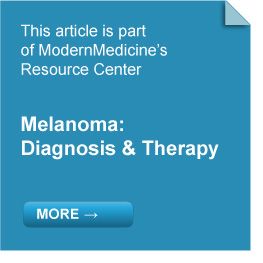- Case-Based Roundtable
- General Dermatology
- Eczema
- Chronic Hand Eczema
- Alopecia
- Aesthetics
- Vitiligo
- COVID-19
- Actinic Keratosis
- Precision Medicine and Biologics
- Rare Disease
- Wound Care
- Rosacea
- Psoriasis
- Psoriatic Arthritis
- Atopic Dermatitis
- Melasma
- NP and PA
- Skin Cancer
- Hidradenitis Suppurativa
- Drug Watch
- Pigmentary Disorders
- Acne
- Pediatric Dermatology
- Practice Management
- Prurigo Nodularis
- Buy-and-Bill
Article
Trial shows benefits to immediate lymph node dissection in some melanoma cases
Author(s):
The results of the first Multicenter Selective Lymphadenectomy Trial (MSLT-1) seem to indicate that survival in patients with intermediate thickness melanoma and metastatic disease in the regional nodes can be improved if early lymph node dissection is performed when a positive sentinel node is identified.

Key Points

This approach may be preferable to performing therapeutic lymph node dissection when disease in regional nodes becomes clinically palpable, says John F. Thompson M.D., professor of surgery, University of Sydney, and executive director of the Melanoma Institute Australia, Sydney.
"The five-year survival of a patient who is sentinel node-positive is approximately 75 percent, which increases to 92 percent in the sentinel node-negative patient, underscoring the huge prognostic importance of the technique. Most patients want to know their status, and the sentinel node biopsy is a relatively trivial procedure which can be performed at the time of wide excision," Dr. Thompson says.
According to Dr. Thompson, the MSLT-1 is the only proper large-scale randomized multicenter trial that has been done for the evaluation of sentinel node biopsy benefit in melanoma, the final results of which are currently being gathered and analyzed. At the moment, however, that there has been no conclusive clinical trial evidence of an overall survival advantage resulting from sentinel node biopsy, though the final results are still pending, he says.
Nevertheless, the third interim analysis has shown several interesting points that speak for the use of the sentinel node biopsy technique, Dr. Thompson says, above and beyond its evident utility as a good prognostic tool in patients with intermediate thickness (Breslow thickness 1.2 mm to 3.5 mm) primary melanoma.
According to Dr. Thompson, results to date have shown that patients who had a positive node sentinel node biopsy and who further underwent an immediate node dissection did much better than patients in the control group of the study who were randomized to observation and who developed nodal disease at a later date detected clinically, and then underwent removal of that node.
"Approximately 20 percent of patients showed a positive node upon sentinel lymph node biopsy. In our opinion, the immediate removal of that node can result in a clinical advantage in that percentage of patients, compared to the patients in whom regional node surgery was delayed until metastasis became clinically detectable," Dr. Thompson says.
SLNB skepticism
Skeptics of the sentinel node biopsy technique would argue that the control group in the MSLT-1 trial that developed nodal metastasis in the course of follow-up was not pre-randomized, rendering a comparison of the SLNB and control groups invalid, Dr. Thompson says.
However, the control group could not have been pre-randomized simply because only one in five patients ever developed nodal disease, Dr. Thompson says.
The SLNB procedure can result in a small number of patients having false negative results, he says, meaning that they will have disease in their nodal field despite having a sentinel node biopsy.
According to Dr. Thompson, if one adds together the number of sentinel node-positive patients with the number of false negative patients, the percentage was exactly the same as the percentage of patients who have developed nodal disease in the observation group of MSLT-1 after eight years of follow-up.
"These data seem to indicate that we are talking about the same patient population and that everyone who is sentinel node positive will eventually go on to develop nodal disease if you do not take out the positive node. If this is so, comparison of the two node-positive groups in MSLT-1 is valid, and the survival benefit for sentinel node-positive patients who have an immediate node dissection is real," Dr. Thompson says.
It is not surprising that the MSLT-1 trial does not show an improvement in survival following sentinel node biopsy in the overall group of patients, Dr. Thompson says, adding that the trial was not powered to do so.
As there are only 20 percent of patients who are sentinel node positive, in order to statistically show an overall survival benefit in that patient population, one would need a study with at least 10,000 patients, he says.
Disclosures: Dr. Thompson reports no relevant financial interests.






